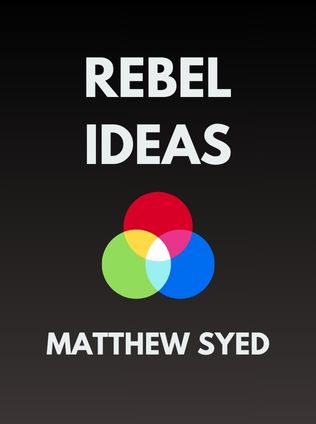
Rebel Ideas
The Power of Diverse Thinking
By Matthew Syed
Published 09/2019
About the Author: Matthew Syed
Matthew Syed is a journalist, broadcaster, and author with a unique talent for exploring the intersections of human potential, performance, and diversity. Born in the United Kingdom, Syed first rose to prominence as a world-class table tennis player, representing Britain at the Olympics. This background in elite sports provided him with deep insights into the psychology of performance, the dynamics of success and failure, and the importance of mindset.
After retiring from professional sports, Syed transitioned to a career in journalism, writing for prestigious publications like The Times. His writing covers a broad range of topics, including sports, psychology, and business. Syed is particularly known for his ability to translate complex scientific concepts into accessible, engaging narratives that resonate with a wide audience. His books, such as Black Box Thinking and Bounce, have been widely acclaimed for their insights into human performance, learning, and the power of practice and resilience.
In Rebel Ideas, Syed takes on the topic of cognitive diversity—how diverse thinking leads to better problem-solving, innovation, and collective intelligence. Drawing on research from psychology, social science, and business, as well as real-world examples from fields as varied as aviation and technology, Syed makes a compelling case for why diversity of thought is essential in today’s complex world.
Main Idea: The Power of Cognitive Diversity
At its core, Rebel Ideas is a book about the transformative power of cognitive diversity. Matthew Syed argues that in a world increasingly defined by complexity, uncertainty, and rapid change, the ability to solve problems, innovate, and make sound decisions requires more than just intelligence or expertise. It requires the integration of different perspectives, ideas, and experiences—a process he terms "cognitive diversity."
Cognitive diversity, as Syed defines it, is the presence of varied thought processes, perspectives, and problem-solving approaches within a group. It is the kind of diversity that goes beyond surface-level differences like race, gender, or socioeconomic status, delving into the deeper differences in how people think and approach problems. Syed’s thesis is that groups composed of individuals with diverse cognitive styles are better equipped to tackle complex problems because they can see things from multiple angles, challenge each other's assumptions, and generate more innovative solutions.
Syed contrasts this with the dangers of homogeneity—when groups are too similar in their thinking, they become prone to "groupthink," echo chambers, and other cognitive traps that can lead to poor decisions and missed opportunities. Through a series of compelling examples and case studies, Syed shows how cognitive diversity can make the difference between success and failure, whether in business, government, or everyday life.
Table of Contents
- Introduction to Diversity Science
- The Dangers of Homogeneity
- The Advantages of Cognitive Diversity
- Communication Within Diverse Groups
- Conclusion: Embracing Diversity for Success
Introduction to Diversity Science
Defining the Problem Space
Syed begins his exploration of cognitive diversity by introducing the concept of the "problem space." The problem space is a mental map of all the possible ideas, perspectives, and knowledge that could be relevant to solving a particular problem. According to Syed, the complexity of modern problems means that no single individual can fully grasp all the aspects of the problem space. This is why diverse groups—those that bring together individuals with different backgrounds, experiences, and ways of thinking—are better at solving complex problems.
For example, consider the challenge of designing a new smartphone. The problem space for this task includes a wide range of knowledge areas: electronics, software development, user interface design, marketing, and more. A group composed solely of software engineers might excel in coding the phone’s operating system, but they would likely struggle with aspects like hardware design or market positioning. By bringing together experts from different fields—engineers, designers, marketers—the group can cover the entire problem space, leading to a more successful product.
Syed emphasizes that cognitive diversity is not just about having different skills or knowledge areas represented in a group. It’s also about having different ways of thinking and approaching problems. This includes different cognitive styles (e.g., analytical vs. intuitive thinking), different cultural perspectives, and different life experiences. The more diverse the group’s cognitive makeup, the more likely it is to come up with creative and effective solutions.
Sign up for FREE and get access to 1,400+ books summaries.
You May Also Like
The Subtle Art of Not Giving a F*ck
A Counterintuitive Approach to Living a Good Life
By Mark MansonRich Dad Poor Dad
What the Rich Teach Their Kids About Money - That the Poor and Middle Class Do Not!
By Robert T. KiyosakiHow To Win Friends and Influence People
The All-Time Classic Manual Of People Skills
By Dale CarnegieFreakonomics
A Rogue Economist Explores the Hidden Side of Everything
By Steven D. Levitt and Stephen J. Dubner



















